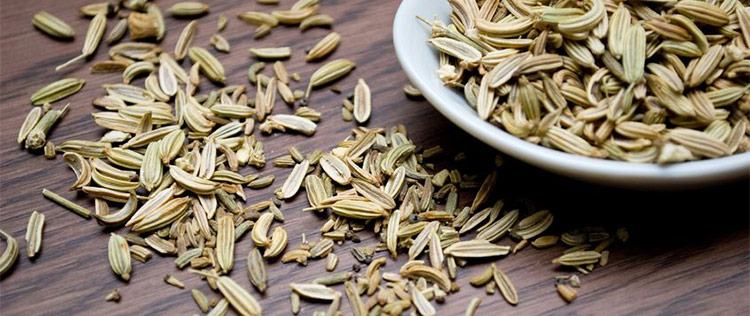Cumin Essential Oil
Cuminum cyminum

Description
When intending to purchase Cumin Essential Oil, it's important to ensure that you doublecheck the method of extraction to ensure that it's steam distilled. If you see that the method of extraction is listed as being cold pressed or expeller pressed, the oil is a carrier oil (vegetable oil) and is not an essential oil. The steam distilled essential oil and the cold pressed carrier oil each offer numerous, but different benefits. For more information on the carrier oil, see AromaWeb's Black Cumin Seed Oil carrier oil profile.
Cumin Essential Oil appears to be comprised primarily of monoterpenes and aldehydes. It's primary component is Cuminaldehyde. Aromatically, a little goes a long way. The oil possesses a rich, spicy, earthy aroma that some find sensual. It is sometimes used within fragrancing applications, and it blends especially well with other oils within the spice, wood and citrus families.
For more information about Cumin Essential Oil, read the details shown below, and be sure to read the the Safety Information section below to learn more about its phototoxic risk within dermal applications.

Cumin Essential Oil Benefits and Uses
- Toxin Buildup
- Poor Circulation
- Low Blood Pressure
- Colic
- Stomach Cramps
- Indigestion
- Gas
- Fatigue
Source: Julia Lawless, The Encyclopedia of Essential Oils (Updated Edition) (London: Harper Thorsons, 2014), 80.
Cumin Essential Oil "...may enhance conventional insecticides against mosquitoes." Reading Chapter 7 of Dr. Jane Buckle's text is highly recommended to understand the context and to view the original source. Source: Jane Buckle, PhD, RN, Clinical Aromatherapy: Essential Oils in Healthcare (Third Edition. United Kingdom: Churchill Livingstone Elsevier, 2015), 132.
Botanical Name
Plant Family
Common Method of Extraction
Steam Distilled
Plant Part Typically Used
Color
Deep Golden Yellow
Consistency
Medium
Perfumery Note
Middle - Base
Strength of Initial Aroma
Medium - Strong
Aromatic Description
Cumin Essential Oil smells spicy, masculine, sensual and earthy.
Major Constituents
- Cuminaldehyde
- Cymene
- Phellandrene
- Myrcene
- Limonene
- Farnesene
- Caryophyllene
Source: Julia Lawless, The Illustrated Encyclopedia of Essential Oils (Rockport, MA: Element Books, 1995), 129.
Cumin Essential Oil Safety Information
Cumin Oil is phototoxic. Robert Tisserand and Rodney Young recommend a dermal maximum of 0.4%. [Robert Tisserand and Rodney Young, Essential Oil Safety (Second Edition. United Kingdom: Churchill Livingstone Elsevier, 2014), 87.] Avoid Cumin Oil during pregnancy. [Julia Lawless, The Illustrated Encyclopedia of Essential Oils (Rockport, MA: Element Books, 1995), 161.] [Robert Tisserand, Essential Oil Safety (United Kingdom: Churchill Livingstone, 1995), 264.]
Cumin Seed CO2 Supercritical Total Extract
In addition to being available as an essential oil, this botanical is available from a small number of reputable sources as a CO2 extract. CO2 extracts offer many advantages. However, they can have differing safety precautions than essential oils because the natural chemistry of CO2 extracts can differ from their essential oil counterparts. Not much safety information is documented from trusted sources for CO2 extracts. Use CO2 extracts with great care and do not assume that every CO2 extract has the same safety precautions as its essential oil counterpart.
General Safety Information
Do not take any oils internally and do not apply undiluted essential oils, absolutes, CO2s or other concentrated essences onto the skin without advanced essential oil knowledge or consultation from a qualified aromatherapy practitioner. For general dilution information, read AromaWeb's Guide to Diluting Essential Oils. If you are pregnant, epileptic, have liver damage, have cancer, or have any other medical problem, use oils only under the proper guidance of a qualified aromatherapy practitioner. Use extreme caution when using oils with children and be sure to first read the recommended dilution ratios for children. Consult a qualified aromatherapy practitioner before using oils with children, the elderly, if you have medical issues or are taking medications. Before using this or any essential oil, carefully read AromaWeb's Essential Oil Safety Information page. For in-depth information on oil safety issues, read Essential Oil Safety by Robert Tisserand and Rodney Young.
Shelf Life
Important Information About the Profiles
The essential oil information provided on AromaWeb is intended for basic educational purposes only. The references to safety information, test results, constituents and percentages is generalized information. Essential oils can vary greatly in composition. The data is not necessary complete and is not guaranteed to be accurate. The essential oil photos are intended to represent the typical and approximate color of each essential oil. However, essential oil composition and color can vary based on harvesting, distillation, age of the essential oil and other factors. Profiles for several CO2 Extracts and absolutes are included within the directory, and are denoted as such.
